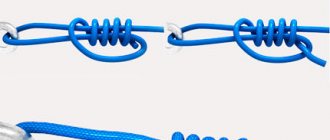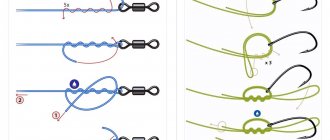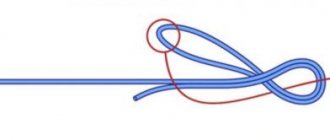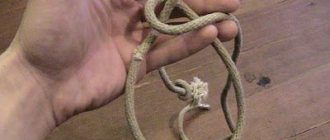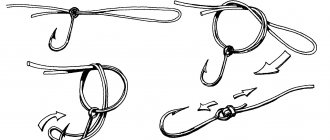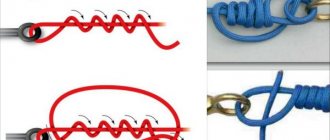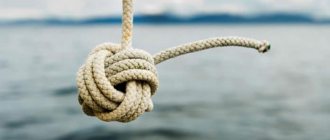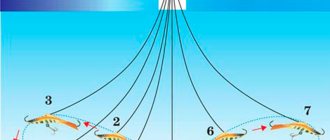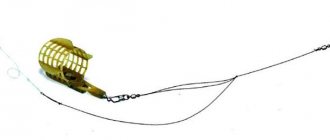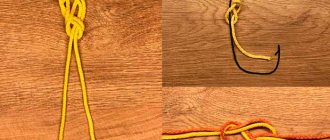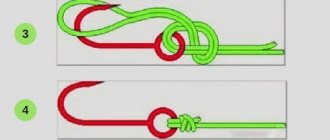“Rapala knot” is a fishing method of fastening baits, developed and offered by . This is a popular Finnish manufacturer of artificial fishing baits.
The unit is designed for wobblers and spinners produced by the company. Its brand name is from . Each product package contains detailed information on how to tie such a loop.
Rapalava fasteners can be used when installing other different types of baits, flies of different weights, streamers, hooks.
Step-by-step knitting pattern
Tying a knot is easy if you know the order of steps:
| 1. At the end of the cord, make a simple knot (15-20 cm not reaching the edge), do not tighten it. | |
| 2. The free end is passed through the eye. | |
| 3. It is inserted into the loose loop of the knot. | |
| 4. The free edge is wrapped around the main cord at least three times. A loop of the required size is formed near the eyelet. | |
| 5. The end of the winding is put back into the loose loop. | |
| 6. Passed into the loop between the running and root ends of the fishing line. | |
| 7. The knot is wetted and tightened. The excess end of the fishing line is cut off. |
It is better to use a non-slip loop with a rapala knot for a wobbler directly. Without an additional leash or other devices. This will improve the performance of the bait. However, it will increase the risk of losing it while fishing for pike. She'll just bite the line.
This fastening method is suitable for almost all produced fishing materials:
- Kevlar;
- fluorocarbon;
- braided;
- monofila.
Before tightening the knot, the line should be wetted. This will make it more durable and extend its service life.
Jam Knot loop, or simply a Rapala knot for wobblers
Some well-known manufacturers of fishing gear inform fishermen on the packaging of their products or on additional inserts about the use of purchased accessories. These include special knots for tying hooks, wobblers and spinners, and methods for tying a fluorocarbon leash to the main braided cord. For example, Varivas, Tict, Rapala are guilty of this.
Today we will talk about a personalized knot from the Rapala company - Jam Knot. Among anglers it is better known as the Rapala knot and Rapala loop.
The Rapala knot is designed for tying a wobbler (spinner) directly to the main fishing line or braid without additional connecting fittings (winding rings, carabiners). As a result of this installation, the wobbler does not have a hard connection that interferes with play. The absence of transition links in the equipment allows predatory fish to react more favorably to passing bait.
From my own experience I will say that if our pike did not have such sharp teeth, I would definitely refuse to use leashes and switch exclusively to the Rapal loop.
The characteristics of Jam Knot contain all the necessary “ingredients”:
- Allows use with minimal line diameters due to the absence of a real knot. That's why it's called a loop.
- Easy to knit. Even beginners are able to tie the bait directly to the fishing spot the first time.
- Can be used with braided cord and monofilament nylon line.
- Sturdy and comfortable.
The formation of the Rapala knot looks like this:
- Stepping back from the working end of the fishing line about 25 centimeters, we make a knot. For further convenience, we tighten it so that there remains a loop with the diameter of a finger.
- We pass the end section of the fishing line through the loop of the wobbler (hook, swivel) and thread it through the loop left on the thread.
- We make several turns with the end around the main fishing line. 4-5 will be enough.
- We again pass the free end of the fishing line into the knot created in the first stage.
- We insert it into the resulting loop, moisten it and carefully pull it together.
- We leave a couple of millimeters and cut off the rest.
And here are the laudatory speeches that Rapala representatives themselves make for this node:
A poorly tied wobbler, of course, will not have the desired effect, so you need to achieve the desired result by choosing the right attachment. It is the Rapala knot that will be the ideal solution, allowing you to immediately feel the difference. Our specialists have developed a special technology. You will be able to carry out the necessary fastening step by step in a few seconds. You don't need to be a professional to make such a knot. The Rapala company always thinks about its customers and tries to help in the fishing process.
No tail, no scales.
There is no such thing as too much information
Pros and cons of the node
The obvious advantages include the ability of the bait, on such a loop, to create natural, natural movements. The knot allows you to make the size of the loop sufficient for the free play of the wobbler (spinner).
Another plus is that most of the strength of the fishing line is retained. The load is transferred to the loop through the center turn, which is ensured by the knitting structure of the knot.
The downside is the inability to use the knot with very thin fishing lines. It has too high (cutting, compressive) forces inside itself.
Well suited for catching perch and pike perch without the use of an additional leash. Its use directly is not advisable for pike fishing.
Historical information about the node
The appearance of some nodal connections has become an extreme necessity due to the birth of new equipment and artificial baits. The mass fascination with wobblers among spinning anglers has revealed a number of negative aspects associated with connecting the bait to the fishing line. It turned out that with a rigid installation option, the mobility of the wobbler is lost. And predatory fish are distrustful of the slightest disruption in the action of the bait.
Specialists from the famous Finnish company Rapala tried to solve the problem of attaching wobblers to fishing line. They noticed that when the wobbler is connected to the thread using a sliding mount, the fish bites better than in the case of a fixed mount. Thus was born the popular Rapalovsky knot, which received the brand name Jam Knot. This is the option recommended in the insert when purchasing wobblers from this Finnish company. What are the strengths and weaknesses of this type of bait-line connection?
What can replace the Rapala knot?
For a wobbler to play well, as intended by the manufacturer, it requires minimal restriction of its free movement in the water. This can be achieved by eliminating all kinds of winding rings, clasps, swivels, and steel leashes. The Rapalava knot does this very well. You can replace it using the following similar fasteners:
Tight loop
Can be used for wobblers and fly fishing.
Knitting pattern:
| A simple flat knot is formed (12 cm from the edge of the fishing line). The free end is threaded through the eye of the wobbler, leaving a loose knot (leaving approximately 9 cm of working length). |
| The knot is tightened (distance from the ear 2 cm). |
| On the main line, using the free part of the tip, another knot is made, wetted and tightened. |
What are the advantages of the design?
1. The Rapal knot is very strong.
2. The line does not wear out in the knot. Most often, the fishing line breaks at the connections. Thanks to its special loop design, the Rapala knot allows you to maintain the strength of the fishing line. This is precisely the reason for its use on fishing line of any diameter, starting from sports diameters.
3. A loose loop does not interfere with the play of the bait, be it a wobbler, a spinner or even a jig.
4. Easy to implement. The sequence of actions is easy to remember. And if you deviate from strictly following the instructions and make, for example, not 5 turns, but 7, then the quality of the assembly will not suffer from this.
5. Does not require any additional elements of fittings: winding rings, swivels, leashes.
6. The Rapala knot is easy to tie on any fishing line, including fluorocarbon.
Properties of the Rapala fishing knot and step-by-step knitting
“Rapala knot” is a fishing method of fastening baits, developed and offered by .
This is a popular Finnish manufacturer of artificial fishing baits. The unit is designed for wobblers and spinners produced by the company. Its brand name is from . Each product package contains detailed information on how to tie such a loop.
Rapalava fasteners can be used when installing other different types of baits, flies of different weights, streamers, hooks.
Rapalava fasteners can be used when installing other different types of baits, flies of different weights, streamers, hooks.
Alternative nodes
To provide the bait with a greater degree of freedom, instead of the Rapala knot, you can use winding rings and clasps (carabiners) for fastening; swivels will also be in place. But due to their weight, these additional elements of equipment located in front of the bait will inevitably make it difficult to play.
There are also alternative loop knots that are not much inferior to the Rapala loop. In addition, you can use non-loop methods for mounting baits.
Tight loop
This installation method is well suited for tying wobblers and flies; they can also be used to attach other baits and equipment. Like the Rapala knot, it provides the maximum degree of freedom. As you can easily see from the diagram, the Tight loop is knitted in a similar way, but it is simpler to perform and does not require such a large consumption of fishing line.
How to knit a tight loop knot is clearly shown in this video:
Blind (corner) loop
Another loop method of attaching baits and equipment elements, which guarantees a very high degree of freedom. In terms of simplicity and speed of knitting, it surpasses the Rapala loop and is not inferior to the Tight loop.
Palomar
A very simple to implement and at the same time very durable method of tying hooks, spinning lures, flies, jigs, swivels, snap hooks and other equipment elements that should be located at the end of the fishing line. Unlike the Rapala knot, it is not a loop knot.
How to tie a Palomar knot is clearly shown in this video:
Clinch
Another very strong and fairly easy to tie knot , which is a worthy alternative to Palomar.
How to tie a Clinch knot is clearly shown in this video:
Uni (Grinner)
Uni is not used as widely as Palomar or Clinch. But the connection strength it provides is also excellent .
How to knit a Uni knot is clearly shown in this video:
Homer
An installation method suitable for tying hooks, swivels and other end elements of equipment, the strength of which is about 90%. The process of tying it is similar to tying the Rapala knot. But, unlike it, Homer is a non-loop connection method, like Palomar, Clinch and Uni.
How to knit a Homer knot is clearly shown in this video:
Fastening to equipment
To properly attach the balancer to the fishing line, you need to understand the nuances of fishing with it and the importance of the quality of the wiring. Game is a decisive factor in catchability. Improper fastening can significantly worsen this indicator.
Correct position
You need to attach the balancer to the fishing line so that it hangs strictly horizontally in the water. This can also be affected by the placement of decorations on hooks. It is acceptable if the nose looks up at a slight angle. To do this, when tying blindly, the knot must pass through the center of the bait ring, and not be located at its base or on the side - in this case, the correct droop will be disrupted. A sliding fastening through a loop, ring or clasp eliminates this problem. How the balancer should hang on the fishing line is sometimes indicated on the packaging (on branded products). If, when tied correctly, the balancer hangs incorrectly, then this is already a jamb of the bait itself. This can be corrected by winding copper wire around the front or back hooks, as well as by manipulating the decorations on them (taking into account the differences in their weight in wet and dry states). High-quality branded products do not have such flaws.
Binding Requirements
To properly attach the balancer to the fishing line, you need to take into account a number of nuances. The performance of the bait depends on their implementation.
- Knots should not weaken the equipment (captain obvious).
- Attaching the balancer to the fishing line does not impair the game.
- The entire binding ensures the correct position with free hanging and movement during the retrieve.
- In general, the fishing line for the balancer needs to be installed correctly.
We tie the spoon and wobbler to the fishing line and leash
There are a large variety of fishing knots. Some are designed for tying fishing line of the same type together, others for tying different types of fishing line. There are also many knots for attaching baits and hooks. Today we will talk about ways to tie a spinner or wobbler to a fishing line. As we know, fishing line differs into types:
- fishing line - “braid”;
- monofilament line;
- fluorocarbon line;
- Fold the end of the fishing line in half and pass it through the bait ring, we will get the first loop.
- Having wrapped the folded end in half with the first loop to the main fishing line, make a second loop on it without tightening it.
- Thread the bait inward through the ring of the first loop.
- We will get two loose loops, pulling the bait and fishing line in different directions - tighten them.
- At the resulting knot, cut off the excess tip of the remaining fishing line.
Properties of the Rapala fishing knot and step-by-step knitting
When assembling fishing equipment, it is necessary to pay close attention to each connection. If our grandfathers used 1-2 methods for tying hooks or spinners, today there are many options for each equipment. Not only are fishermen coming up with new ideas, but also manufacturers of fishing lines and baits are offering their own solutions. One such example is the Rapala knot. Where did this interesting type of editing appear and what are its strengths?
When assembling fishing equipment, it is necessary to pay close attention to each connection. If our grandfathers used 1-2 methods for tying hooks or spinners, today there are many options for each equipment. Not only are fishermen coming up with new ideas, but also manufacturers of fishing lines and baits are offering their own solutions. One such example is the Rapala knot. Where did this interesting type of editing appear and what are its strengths?
How to tie fishing knots correctly
So, friends! You've fallen in love with spinning fishing, bought an excellent spinning rod and a reel for it, and wound a strong cord. There are many wobblers, spinners and other types of bait in your box. In general, you are ready to catch your first trophy. But there is a very important point: before you understand the intricacies of casting and animation of lures, it is important for you to learn not to lose them when playing fish or getting caught on underwater obstacles. And for this you need to learn how to knit reliable fishing knots.
The safety of the bait and the effectiveness of your fishing will depend on how you learn to tie them. Simple types of knots significantly worsen the strength of the braided veins (fishing line), which usually leads to rupture of the fishing tackle at the most crucial moment and the loss of expensive bait.
Therefore, it is important to learn how to tie exactly the kind of knots that will minimally injure the thread. A good knot usually retains 95-96% of the original strength of the fishing line or braid. Fortunately, the long-term practice of many fishermen has determined the most durable of the knots. All you have to do is practice tying them slowly at home. As they say, “hard to learn, easy to fight.” Know that the time you spend learning and mastering reliable types of knots will make your fishing successful and help preserve both your bait and your catch.
So, first of all, the knot must correspond to the task that the fisherman assigns to it. Usually, knots are used to connect the main line (braid) and the leash, the line and hooks, swivels, clasps, winding rings and, of course, the bait.
